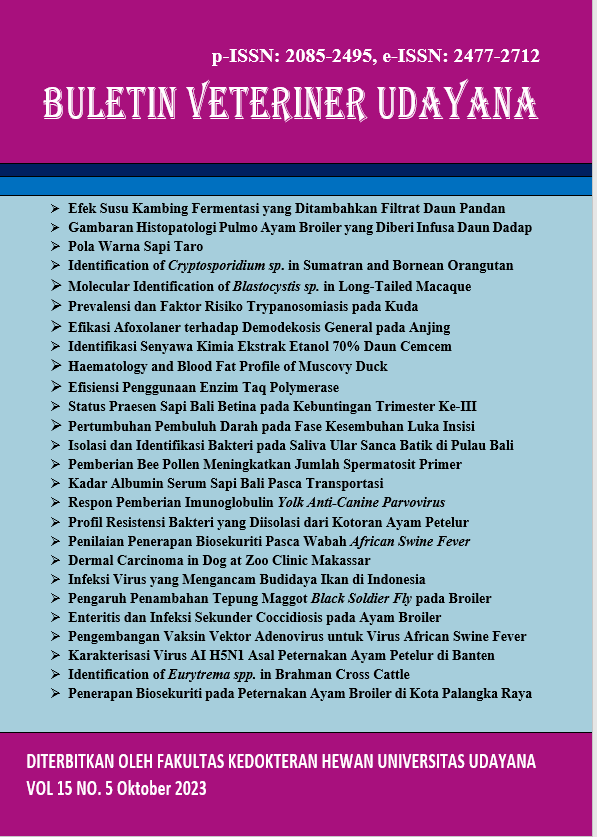DEVELOPMENT OF A DNA VACCINE WITH NUCLEOPROTEIN GENE OF THE SARS-COV-2 VIRUS
Abstract
DNA vaccines have become an interesting area of research in the fight against infectious diseases in animals and humans. DNA vaccines are vaccine formulations that use DNA fragments as antigens. The DNA in vaccines contains genetic information extracted from the disease agent, such as a virus or bacteria, that it is trying to target. This research aims to develop DNA vaccines in animals and humans. We developed plasmid DNA clones with the Covid-19 virus nucleoprotein gene that was transformed into E. coli stellar bacteria. The vaccine was injected in mice. The antibody was tested using an Enzyme-linked immunosorbent assay with purified recombinant NP protein. The results of the study showed that a clone of plasmid DNA with the nucleoprotein gene of the SARS-Cov-2 virus could be developed and proven. Administration of plasmid DNA clones with nucleoprotein genes in mice could induce the formation of specific antibodies against the nucleoprotein of the SARS-Cov-2 virus. The antibodies were increased from week 1 to weeks 4 and 5 then decreased in week 6 post-vaccination.
Downloads
References
Gu J, Korteweg C. 2007. Pathology and pathogenesis of severe acute respiratory syndrome. Am. J. Pathol. 170: 1136-1147.
Guo YR, Cao QD, Hong ZS, Tan YY, Chen SD, Jin HJ, Tan KS, Wang DY, Yan Y. 2020. The origin, transmission and clinical therapies on coronavirus disease 2019 (COVID-19) outbreak - an update on the status. Mil. Med. Res. 7: 11.
Harris PE, Brasel T, Massey C, Herst CV, Burkholz S, Lloyd P, Blankenberg T, Bey TM, Carback R, Hodge T, Ciotlos S, Wang L, Comer JE, Rubsamen RM. 2021. A synthetic peptide CTL vaccine targeting nucleocapsid confers protection from SARS-CoV-2 challenge in rhesus macaques. Vaccines. 9(5): 520.
Inoue H, Nojima H, Okayama H. 1990. High efficiency transformation of Escherichia coli with plasmids. Gene. 96: 23-28.
Jeewandara C, Aberathna IS, Pushpakumara PD, Kamaladasa A, Guruge D, Wijesinghe A, Gunasekera B, Ramu ST, Kuruppu H, Ranasinghe T, Dayarathna S, Dissanayake O, Gamalath N, Ekanayake D, Jayamali J, Jayathilaka D, Dissanayake M, Jayadas TT, Mudunkotuwa A, Somathilake G, Harvie M, Nimasha T, Danasekara S, Wijayamuni R, Schimanski L, Rijal P, Tan TK, Dong T, Townsend A, Ogg GS, Malavige GN. 2022. Persistence of immune responses to the Sinopharm/BBIBP-CorV vaccine. Immun. Inflam. Dis. 10: e621.
Kiros M, Andualem H, Kiros T, Hailemichael W, Getu S, Geteneh A, Alemu D, Abegaz WE. 2020. COVID-19 pandemic: current knowledge about the role of pets and other animals in disease transmission. Virol. J. 17: 143.
Liu DX, Fung TS, Chong KK, Shukla A, Hilgenfeld R. 2014. Accessory proteins of SARS-CoV and other coronaviruses. Antiviral. Res. 109: 97-109.
Liu J, Chang W, Pan L, Liu X, Su L, Zhang W, Li Q, Zheng Y. 2018. An Improved method of preparing high efficiency transformation Escherichia coli with both plasmids and larger DNA fragments. Indian J. Microbiol. 58: 448-456.
Liu YC, Kuo RL, Shih SR. 2020. COVID-19: The first documented coronavirus pandemic in history. Biomed J. 43(4):328-333.
Omma A, Batirel A, Aydin M, Yilmaz Karadag F, Erden A, Kucuksahin O, Armagan B, Guven SC, Karakas O, Gokdemir S, Altunal LN, Buber AA, Gemcioglu E, Zengin O, Inan O, Sahiner ES, Korukluoglu G, Sezer Z, Ozdarendeli A, Kara A, Ates I. 2022. Safety and immunogenicity of inactive vaccines as booster doses for COVID-19 in Turkiye: A randomized trial. Hum. Vac. Immunother. 18: 2122503.
Putra A, Widyatmoko A, Ibrahim S, Amansyah F, Amansyah F, Berlian MA, Retnaningsih R, Pasongka Z, Sari FE, Rachmad B. 2021. Case series of the first three severe COVID-19 patients treated with the secretome of hypoxia-mesenchymal stem cells in Indonesia. F1000 Res. 10: 228.
Santi T, Sungono V, Kamarga L, Samakto B, Hidayat F, Hidayat FK, Satolom M, Permana A, Yusuf I, Suriapranata IM, Jo J. 2022. Heterologous prime-boost with the mRNA-1273 vaccine among CoronaVac-vaccinated healthcare workers in Indonesia. Clin. Exp. Vac. Res. 11: 209-216.
Sharma O, Sultan AA, Ding H, Triggle CR. 2020. A Review of the Progress and Challenges of Developing a Vaccine for COVID-19. Front. Immunol. 11: 585354.
Skariyachan S, Challapilli SB, Packirisamy S, Kumargowda ST, Sridhar VS. 2019. Recent aspects on the pathogenesis mechanism, animal models and novel therapeutic interventions for middle east respiratory syndrome coronavirus infections. Front. Microbiol. 10: 569.
Thanh LT, Andreadakis Z, Kumar A, Gómez Román R, Tollefsen S, Saville M, Mayhew S. 2020. The COVID-19 vaccine development landscape. Nat. Rev. Drug Discovery. 19: 305-306.
Wang H, Gan M, Wu B, Zeng R, Wang Z, Xu J, Li J, Zhang Y, Cao J, Chen L, Di D, Peng S, Lei J, Zhao Y, Song X, Yuan T, Zhou T, Liu Q, Yi J, Wang X, Cai H, Lei Y, Wen Y, Li W, Chen Q, Wang Y, Long P, Yuan Y, Wang C, Pan A, Wang Q, Gong R, Fan X, Wu T, Liu L. 2023. Humoral and cellular immunity of two-dose inactivated COVID-19 vaccination in Chinese children: A prospective cohort study. J. Med. Virol. 95: e28380.
Yuan Y, Xu J, Ma B, Chen G, Wang Z, Wang S, Jing N, Zhang J, Wang B, Yan W, Zhang Q, Zhao Q, Li Y. 2023. Characteristics of humoral and cellular responses to coronavirus disease 2019 (COVID-19) inactivated vaccine in central China: A prospective, multicenter, longitudinal study. Front. Immunol. 14: 1107866.
Zhou P, Yang XL, Wang XG, Hu B, Zhang L, Zhang W, Si HR, Zhu Y, Li B, Huang CL, Chen HD, Chen J, Luo Y, Guo H, Jiang RD, Liu MQ, Chen Y, Shen XR, Wang X, Zheng XS, Zhao K, Chen QJ, Deng F, Liu LL, Yan B, Zhan FX, Wang YY, Xiao GF, Shi ZL. 2020. A pneumonia outbreak associated with a new coronavirus of probable bat origin. Nature. 579: 270-273.
Zhu M. 2004. SARS Immunity and vaccination. Cell Mol. Immunol. 1: 193-198.





